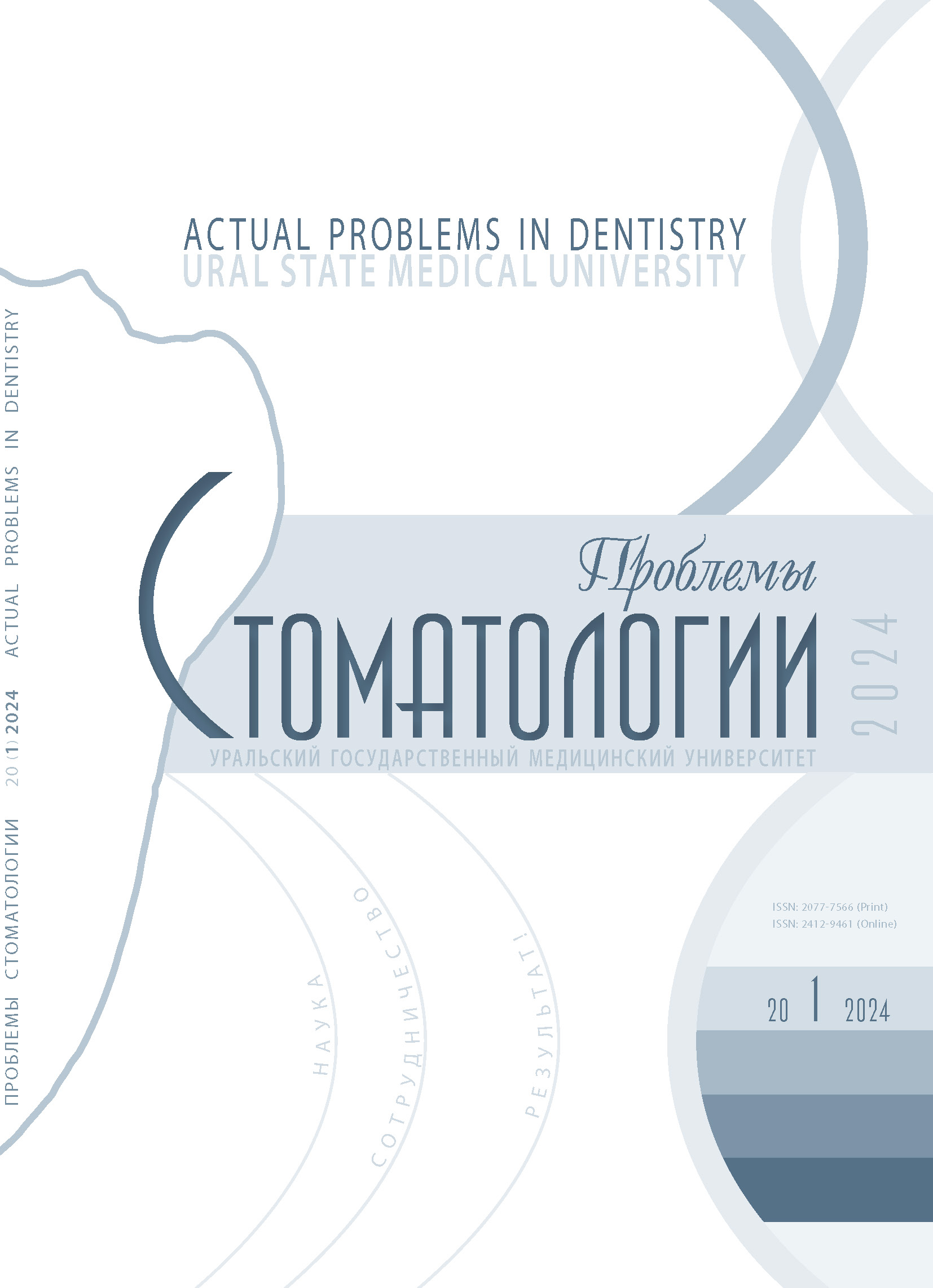Perm', Perm, Russian Federation
Perm, Perm, Russian Federation
from 01.01.2015 until now
Perm, Perm, Russian Federation
Perm, Perm, Russian Federation
UDC 616.31
Subject. Today, the use of splint therapy is an essential part of specialized dental treatment, since in recent years the number of patients with dysfunctional conditions of the dentofacial apparatus, has increased significantly. In addition, according to recent research, the use of occlusal splints as part of complex therapy is effective in the treatment of neurological diseases, such as bruxism, chronic tension-type headache, and neuromuscular syndrome. Traditionally used designs of occlusal splints have some disadvantages, such as fragility of use, insufficient rigidity, and the impossibility of relining if the patient's dental status changes. The article provides a description and clinical and laboratory stages of manufacturing the developed new design of an occlusal splint reinforced with a titanium frame. Objectives. Increasing the effectiveness of treatment of patients with functional disorders of the dentofacial system through the development and implementation of a new prosthetic construction – a combined occlusal splint with a titanium frame, using modern intellectual and medical 3D technologies. Materials and methods. Titanium alloy (Rematitan®) was chosen as the material for the frame of the occlusal splint. Manufacturing method implies the use of additive technologies, in particular, 3D-printing for obtaining a high-precision structure with a minimum cross-sectional thickness. Hot-curing acrylic plastic was used to cover the parameterized frame; it is also possible to use a light-curing composite. Results. During the study, the expediency of introducing a reinforcing component in the form of a metal frame into the construction of the occlusal splint was determined. A new design of a combined occlusal splint and a method for its manufacture were developed. Conclusion. By reinforcing the occlusal splint with a titanium frame, high structural strength, durability of use, maintainability or relocation if necessary are ensured; at the same time, due to 3D-printing, the frame has a minimal cross-sectional thickness, which practically does not affect the thickness of the structure as a whole.
occlusal splint, splint therapy, prosthetic construction frame, digital technologies, muscular-articular dysfunction
1. Abakarov S.I., Alimskiy A.V., Antonik M.M. i dr. Ortopedicheskaya stomatologiya. Nacional'noe rukovodstvo. Moskva : "GEOTAR-Media". 2019:579. [S.I. Abakarov, A.V. Alimsky, M.M. Antonik et al. Orthopedic dentistry: National guidelines. Moscow : “GEOTAR-Media”. 2019:579. (In Russ.)]. https://www.geotar.ru/lots/NF0012676.html
2. Manrriquez S.L., Robles K., Pareek K., Besharati A., Enciso R. Reduction of headache intensity and frequency with maxillary stabilization splint therapy in patients with temporomandibular disorders-headache comorbidity: a systematic review and meta-analysis // J Dent Anesth Pain Med. – 2021;21(3):183-205. DOI:https://doi.org/10.17245/jdapm.2021.21.3.183.
3. Ibragimova R.S., Daulethozhaev N.A., Rusanov V.P., Mirzakulova U.R. Rasprostranennost' klinicheskih priznakov funkcional'nyh narusheniy visochno-nizhnechelyustnogo sustava u lic srednego, pozhilogo i starcheskogo vozrastov. Vestnik KazNMU. 2013;4-2. [R.S. Ibragimova, N.A. Dauletkhozhaev, V.P. Rusanov, U.R. Mirzakulova. Prevalence of clinical signs of functional disorders of the temporomandibular joint in persons of middle, elderly and senile age. Bulletin of KazNMU. 2013;4-2. (In Russ.)]. https://cyberleninka.ru/article/n/rasprostranennost-klinicheskih-priznakov-funktsionalnyh-narusheniy-visochno-nizhnechelyustnogo-sustava-u-lits-srednego-pozhilogo-i
4. Saha F.J., Pulla A., Ostermann T., Miller T., Dobos G., Cramer H. Effects of occlusal splint therapy in patients with migraine or tension-type headache and comorbid temporomandibular disorder: A randomized controlled trial // Medicine (Baltimore). – 2019;98(33):e16805. DOI:https://doi.org/10.1097/MD.0000000000016805.
5. Syed M.S., Ahmed M.D. Muscle Contraction Tension Headache Clinical Presentation. https://emedicine.medscape.com/article/1142908-overview
6. Kobzeva N.R., Lebedeva E.R., Olesen E. Rasprostranennost' migreni i golovnyh boley napryazheniya v mire (obzor literatury). Ural'skiy medicinskiy zhurnal. 2016;04(137):69-75. [N.R. Kobzeva, E.R. Lebedeva, E. Olesen. Prevalence of migraine and tension-type headache in the world (literature review). Ural Medical Journal. 2016;04(137):69-75. (In Russ.)]. https://brightwaygroup.ru/upload/iblock/c17/Rasprostranennost-migreni-i-golovnykh-boley-napryazheniya-v-mire-_obzor-literatury_.pdf
7. Belimova L.N., Balyazin V.A. O patofiziologicheskih osnovah golovnoy boli napryazheniya. Kubanskiy nauchnyy medicinskiy vestnik. 2016;5:139-147. [L.N. Belimova, V.A. Balyazin. The pathophysiological basis of tension-type headache. Kuban Scientific Medical Bulletin. 2016;5(160):139-147. (In Russ.)]. https://cyberleninka.ru/article/n/o-patofiziologicheskih-osnovah-golovnoy-boli-napryazheniya
8. Borodina I.D., Apresyan S.V., Stepanov A.G., Butkov D.S., Sanosyan G.V. Klinicheskaya effektivnost' okklyuzionnyh shin v lechenii pacientov s disfunkciey visochno-nizhnechelyustnogo sustava, oslozhnennoy bruksizmom. Stomatologiya. 2023;102(5):56-60. [I.D. Borodina, S.V. Apresyan, A.G. Stepanov, D.S. Butkov, G.V. Sanosyan. Clinical efficiency of occlusive splints in the treatment of patients with temporomandibular joint dysfunction complicated by bruxism. Stomatologiya. 2023;102(5):56 60. (In Russ.)]. https://doi.org/10.17116/stomat202310205156
9. Naumovich S.A., Naumovich S.S. Okklyuzionnye shiny: vidy i rol' v kompleksnoy terapii patologii visochno-nizhnechelyustnogo sustava. Sovremennaya stomatologiya (Minsk). 2014;1:7-10. [S.A. Naumovich, S.S. Naumovich. Occlusal splints: types and role in complex therapy of temporomandibular joint pathology. Modern dentistry (Minsk). 2014;1:7-10. (In Russ.)]. https://cyberleninka.ru/article/n/okklyuzionnye-shiny-vidy-i-rol-v-kompleksnoy-terapii-patologii-visochno-nizhnechelyustnogo-sustava
10. Fadeev R.A., Ovsyannikov K.A., Zhidkih E.D. Primenenie okklyuzionnyh kapp i lechebno-diagnosticheskih apparatov dlya lecheniya zabolevaniy visochno-nizhnechelyustnogo sustava i zhevatel'nyh myshc. Institut stomatologii. 2020;3(88):78-81. [R.A. Fadeev, K.A. Ovsyannikov, E.D. Zhidkikh. The use of occlusal splints and medical diagnostic devices for the treatment of diseases of the temporomandibular joint and masticatory muscles. Institute of Dentistry. 2020;3(88):78-81. (In Russ.)]. https://instom.spb.ru/catalog/article/15326/
11. Amin A., Meshramkar R., Lekha K. Comparative evaluation of clinical performance of different kind of occlusal splint in management of myofascial pain // J Indian Prosthodont Soc. – 2016;16 (2):176-181. DOI:https://doi.org/10.4103/0972-4052.176521.
12. Astashina N.B., Starikova N.L., Valiahmetova K.R. Sovremennyy vzglyad na problemu splint-terapii pri lechenii hronicheskoy golovnoy boli napryazheniya. Permskiy medicinskiy zhurnal. 2021;38(3):61-67. [N.B. Astashina, N.L. Starikova, K.R. Valiakhmetova. A modern view on the problem of splint therapy in the treatment of chronic tension-type headache. Perm Medical Journal. 2021;38(3):61-67. (In Russ.)]. https://permmedjournal.ru/PMJ/article/view/76005
13. Akbulut N., Altan A., Akbulut S., Atakan C. Evaluation of the 3 mm thickness splint therapy on temporomandibular joint disorders (TMDs) // Pain Res Manag. – 2018;5;2018:3756587. DOI:https://doi.org/10.1155/2018/3756587.



















